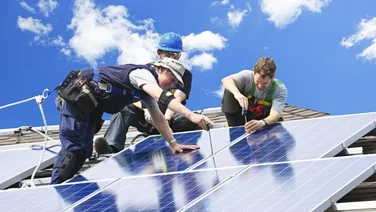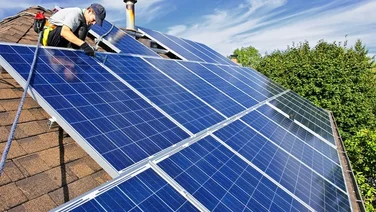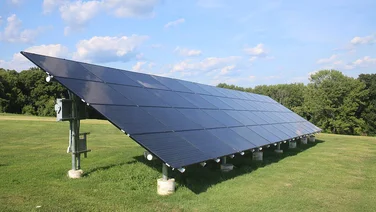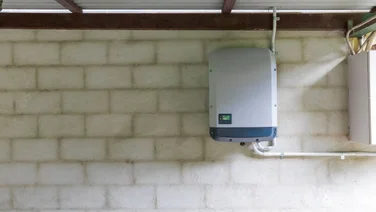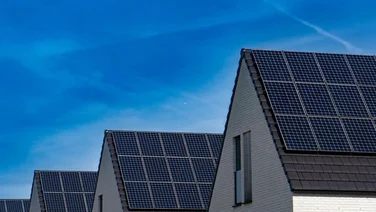- You can install as many solar panels as you want – there’s no legal limit in the UK
- But if your system exceeds 3.68 kWp, your installer must get approval from your local electricity network (DNO)
- Bigger isn’t always better – oversized systems often cost more than they save

If you’re wondering ‘how much do solar panels cost?’ then good news, the cost of solar panels continues to tumble – falling by 4.5% from March 2024-2025 – and they can cut your energy bills by 70%, so it’s understandable to get as many as possible, especially with the government grants that help with the upfront cost.
In this guide, we’ll look at the details of many solar panels you can have installed.
If you want to go solar at any point, you can compare solar panel prices with our help. Just provide a few quick details, and our expert installers will be in touch with free quotes for you to compare.
Where do you want to install solar panels?
Get startedWhat’s the maximum number of solar panels you can have?
In short, there isn’t one, you can have as many solar panels on your roof as you like. Nothing legally prevents you from having as many solar panels as you want or can afford.
There is, however, a physical limit based on the size of the space you have on your roof or land to put them. However, it is possible to have too many solar panels in terms of cost-effectiveness. If you produce more solar energy than you need, you’ll end up overpaying for the system.
But as long as they’re safely installed, properly connected to your electricity supply, entirely situated on your property, and follow all relevant planning permission rules (though solar panels are usually considered permitted development), nothing is stopping you from having as many solar panels as you want.
No, there is no limit on how many solar panels you can have on your property.
As long as you don’t break any local planning rules, you can buy all the solar panels you want – just make sure they’ll fit on your roof and/or land first.
There’s also no limit on how much power you can generate. However, if your system’s capacity is over 3.68 kWp, your installer will have to gain approval from your Distribution Network Operator (DNO) first, unless you have a three-phase electricity supply.
Is there a maximum amount of solar energy you can produce?
Once again, in short, there is no maximum amount of solar energy production limit in the UK (beyond physical limitations, of course). If you are interested in finding out how much power your panels can produce, check out our solar panel output calculator.
That said, your solar panel installer must inform your Distribution Network Operator (DNO) – the company controlling the hardware that supplies your area with electricity – before installing a system with a peak power capacity above 3.68 kWp per phase.
That means if you have a single-phase setup, as the great majority of UK homes do, you’ll need prior approval for any installation above 3.68 kWp.
A household with three-phase electricity will be able to install 11.04 kWp – 3.68 kWp for each of its phases, without asking for permission in advance of the installation.
Upgrading your electricity supply from single-phase to three-phase typically costs between £3,500 and £8,000.
If your installer does have to ask for approval before the job, that’s no reason to worry. Solar panel systems under 5 kWp are usually approved without any issues. Installations above 5 kW typically require additional checks, but still almost always receive a stamp of approval, albeit with a slight delay.
Again, while there is no physical or legal limit on the amount, you can end up overpaying if you produce more energy than you need.
If you have more solar panels than you need, your system won’t be as cost-effective as it could be.
That means you’ll take longer to break even on your solar panels, and your overall return on investment will be worse.
Use our solar panel calculator to find out approximately how many panels you should buy for your home.
How many solar panels can the average roof hold?
Totals vary, but the average roof on a three-bedroom house in the UK can hold between 10 and 20 solar panels.
By way of example, consider a home with a roof area of 70 m², which is enough space to fit five rows of four solar panels. Considering that solar panels are usually about 2 m², you should, in theory, be able to accommodate more than 20 on such a roof.
However, your installer is legally required to leave at least 20 cm of space between your panels and the edge of the roof on every side.
They’ll also usually ensure there’s about 15 cm between each row of solar panels, to give the frames space to contract and expand as temperatures change throughout the year.
Thankfully, space is usually the only issue, as most UK roofs can typically support the weight of a solar panel installation.
Our roofs can usually support at least 108 kg per square metre, which is 12.5 times as much as the average solar panel needs. However, older roofs, especially those originally designed to hold quarry slate, may have significantly reduced weight-bearing capacities.
Your solar panel installer will advise you in any case.
How many solar panels should I get?
The average three-bedroom household should have 10 solar panels.
We’re assuming this home consumes 2,700 kWh of electricity per year – the national average – and will use 50% of its solar energy, which again is typical.
The average one-bedroom house should get six solar panels, while a bigger household with four or five bedrooms will usually need 14 panels.
Check out our guide to see how many solar panels you need for your home.
You only need to seek approval from your Distribution Network Operator (DNO) before your solar panel installation if its capacity will be over 3.68 kWp per phase.
Since most UK homes have single-phase electricity, this means anything over 3.68 kWp will require you to gain permission beforehand.
DNOs usually approve solar panel installations without too much trouble or delay, though.
Are there any downsides to large solar panel systems?
Aside from the upfront cost, there are no downsides to large solar panel systems, as long as it makes sense for your household.
If you use a lot of electricity – for instance, more than 4,000 kWh per year – you can save several hundred pounds on your energy bills per year with solar panels.
But if you buy a solar panel system that produces significantly more electricity than you can use, you won’t break even as quickly.
You’ll still make money from exporting your excess energy to the grid, through the Smart Export Guarantee, but you’ll almost certainly receive less than you pay the grid for electricity.
This means that every extra solar panel you install above the optimal number for your home will add 0.4 years to your break-even point, on average.
To work out what size solar panel system you need, just use our solar panel output calculator.
Summary
- There’s no legal limit to how many solar panels you can install in the UK
- Most homes can support 10 to 20 panels, depending on roof space and layout
- Systems above 3.68 kWp usually need prior approval from your DNO
- Oversized solar systems take longer to break even and offer lower returns
- Three-phase power lets you install larger systems without extra approvals
- Use our calculator to find your ideal system size and get free quotes from trusted installers


